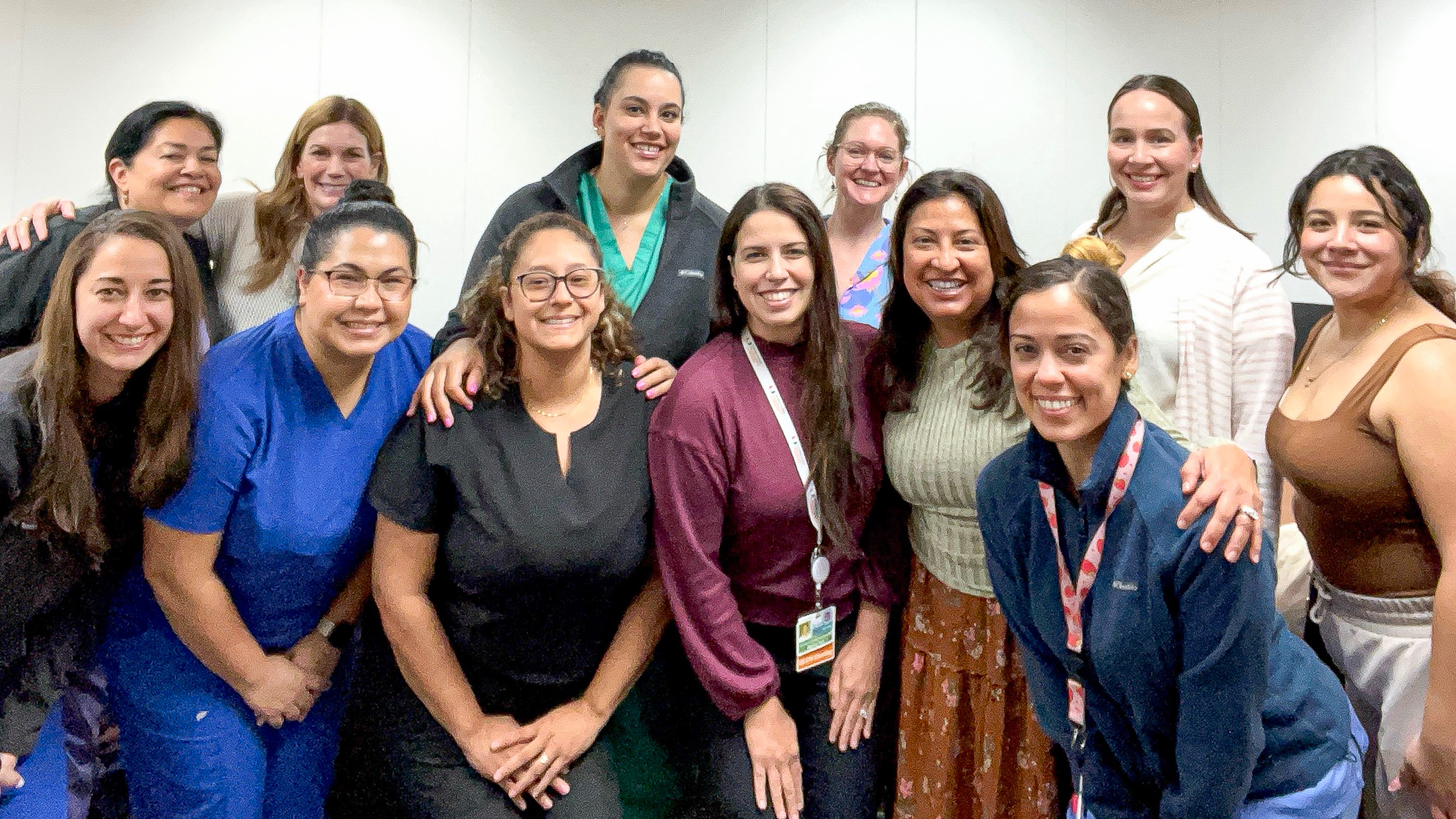Pilot study looks to improve minority maternal health outcomes

School of Communication News
3-26-2025
As recipients of a recent pilot grant award, researchers at the University of Miami School of Communication and Miller School of Medicine Department of Obstetrics, Gynecology and Reproductive Sciences launched a study titled “Implementation and Evaluation of a Pilot Group Prenatal Care Program to Address Bias and Improve Minority Maternal Health Outcomes.” Researchers Victoria Orrego Dunleavy, associate professor in the Department of Communication Studies, and Dr. Veronica Alvarez-Galiana, assistant professor of Obstetrics, Gynecology and Reproductive Sciences, will explore group prenatal care (GPNC) and its proven success as an effective method of care for pregnant women.
GPNC has been shown to reduce preventable maternal mortality and severe maternal morbidity. Through the pilot study, the researchers leveraged an existing GPNC model with unique elements including increased patient-provider contact, a variety of group members, group setting, and patient-led agenda to better inform current recommendations, reduce clinician bias, and decrease maternal health inequalities.
The researchers will be the first to introduce GPNC as an alternative to traditional individual care for low-risk patients to UHealth—University of Miami Health System and Jackson Health System.
Orrego Dunleavy explained the pilot study and its outcomes.
What inspired you and Dr. Alvarez-Galiana to pursue this pilot study on group prenatal care (GPNC) and maternal health outcomes?
Both Dr. Alvarez- Galiana and I share an interest in improving maternal health outcomes. Dr. Alvarez-Galiana, as a practicing OB/GYN physician serving our community, has had past experience participating in GPNC, saw the benefits of it during her residency, and was determined to bring it here to Miami.
My past work in rural Guatemala working with Mayan birth attendants culturally tailoring group-centered HIV and sexual health programming fostered my interest in pursuing similar work in the U.S. I also saw the direct benefits of implementing sexual education in a safe and supportive group setting.
I think that as Latina professionals in health-related fields working with diverse populations, we have a deep appreciation for and a determination to foster patient-centered maternal care within our multicultural community. We were fortunate to meet and collaborate on this pilot project.
Can you explain how GPNC differs from traditional individual prenatal care, and why it is particularly beneficial for minority maternal health outcomes?
GPNCs have been implemented for more than 20 years and have been shown to have a positive effect on pregnancy and birth outcomes, particularly for underserved populations.
GPNC visits take place every two weeks for two hours until delivery (13 sessions) and include four postpartum group sessions. Each group session begins with a 30-minute medical check-in and brief individual prenatal exam.
As patients arrive at the site, they bypass the waiting area and report directly to the group space where they can socialize, measure their blood pressure, and weigh themselves. The remaining hour and a half consist of a facilitated group discussion, guided by patients’ personal knowledge and experiences around common issues during pregnancy. Topics include prenatal health, labor, infant care, nutrition, parenting, behavior changes, and communication.
Research has demonstrated that GPNC has a positive effect on several pregnancy and birth related outcomes such as low birth weight, preterm birth, gestational weight gain, and adequacy of care as well as on provider communication and wellness.
Facilitated discussions consider patients’ lived experiences, which in turn help clinicians modify and improve the curriculum of the group learning. This approach of continuous modification and improvement based on patient needs provides an excellent base from which to develop and improve clinician behavior and address health inequities.
In GPNC programs, clinicians spend upwards of 20 contact hours with patients, compared to 2.5 in traditional care. This increased engagement provides deeper insight into aspects of patients’ lives that may impact their care and improves patient-clinician rapport. Studies have shown that repeated cross-cultural exposure can reduce both implicit and explicit forms of bias in clinicians.
How does your background in communication inform your approach to addressing clinician bias in maternal health care?
Communication is at the core of GPNC, as the focus is on accessible and comprehensive medical care and education in a supportive group of peers and medical professionals. I know how important patient-provider communication is to facilitating trust, empathy, self-disclosure—essentially patient-centered care. Prior research suggests moderate to strong
levels of bias among health care providers across diverse knowledge levels and disciplines as early as their first year of medical school.
Perception of bias may contribute to patient late entry to care and reduced patient-provider communication, such as reluctance to ask questions, failure to disclose important health information, decreased satisfaction, and traumatic birth experiences.
Clinician bias affects patient-provider communication and treatment decisions as well. An increasing number of researchers and health care professionals suggest GPNC may be a vehicle with which to influence clinician bias and improve communication. Our team of researchers and providers recently underwent GPNC training from our community partner Pregnancy and Parenting Partners (P3) to learn about the intervention format and content, and the group centered focus on open and supportive communication.
I will be co-facilitating our first cohort of GPNC sessions at our Jackson South Clinic. I look forward to applying my group facilitation skills, in addition to learning from our patients on what is needed and valued by them during their prenatal care.
What are some of the key elements of the existing GPNC model you are leveraging, and how do they help mitigate health care disparities?
We are leveraging the wealth of experience that our community partner, P3, brings to the specific GPNC program we will be implementing at Jackson Health System.
An essential component to community-based research is to partner with agencies who have on-ground expertise and experience working with the target population. It is very important for us to build a team of experts who all bring different yet complementary skills sets to address such an important issue as maternal and infant health.
Our community partner, P3, is an organization that developed a GPNC program to improve health outcomes through accessible and comprehensive medical care and education in a supportive group of peers and medical professionals. P3 is informed by the curriculum of the Nurse Family Partnership, a widely implemented maternal and early child health program specifically targeted to address the needs of underserved families from birth to early childhood.
Designed using health promotion and group theories that are applied to the curriculum to promote deeper learning and empowerment and provide the social benefits of group care, P3 has been implemented in 14 sites across five states in a variety of clinic settings— including large hospital systems and community clinics. This expertise will guide our approach as we begin piloting P3 GPNC at Jackson Health System—the only safety-net system in Miami.
How do you see this program influencing future maternal healthcare policies and practices on a broader scale?
We are just at the beginning of this process, with the goal being an effective and sustainable program within Jackson Health System. This study is novel, as it will be the first GPNC in Miami—a racially, ethnically, and socioeconomically diverse community. At the conclusion of our study, we will be able to determine the extent to which GPNC can be used as a sustainable model of care to help improve maternal and infant health outcomes as well as provider wellness and patient-provider communication—a pillar of patient centered care. Jackson Health System is in a unique position to address diverse community health with innovative and engaging care for mothers and babies.
What are the next steps for this research after the pilot study, and do you foresee expanding the program if it proves successful?
The next steps are to disseminate our research findings when the pilot is completed and pursue continuation funds that will lead to larger external funding that would move the project towards a randomized clinical trial to definitively assess impact for our community and acceptance within Jackson Health System as a recognized form of prenatal care, alongside traditional individual prenatal care.
Currently, we are looking for additional funds, “Implementation and Evaluation of a Pilot Group Prenatal Care Program to Improve Maternal Health Outcomes and Provider-Patient Communication: Moving towards Scalability and Sustainability,” where we seek to continue the implementation of our P3 program by supplementing efforts to increase program effectiveness and sustainability within the Jackson Health System.






